Content for TS 23.379 Word version: 19.5.0
1…
7…
10…
10.5…
10.6…
10.6.2.3…
10.6.2.4…
10.6.2.5…
10.6.2.6…
10.6.2.9…
10.6.3…
10.7…
10.7.3…
10.7.5…
10.7.6…
10.9…
10.9.1.3.3…
10.9.1.4…
10.9.2…
10.10…
10.12…
10.19…
10.19.3…
10.19.3.1.4…
10.19.3.2…
10.19.3.2.4…
10.19.3.2.6…
A…
10.6.3 Off-network group call
10.6.3.1 General
10.6.3.2 Information flows for group call in off-network
10.6.3.3 Group call setup
10.6.3.4 Passive join to group call
10.6.3.5 Join to ongoing group call when new entry member initiates the call with on-going group call id
10.6.3.6 Immediate group call announcement to join an ongoing group call
10.6.3.7 Group call release due to inactivity
10.6.3.8 Broadcast group call
10.6.3.9 Emergency and imminent peril procedures
...
...
10.6.3 Off-network group call p. 101
10.6.3.1 General p. 101
When an MCPTT user using a ProSe-enabled UE wants to communicate with a specific MCPTT group using ProSe capabilities, the MCPTT client enables the use of the ProSe layer procedures for public safety, as specified in TS 23.303.
The MCPTT client obtains configuration data such as the user info ID of the calling MCPTT user and the ProSe Group IP multicast address and ProSe Layer-2 Group ID associated to the target MCPTT group (as described in clause 8.1.3.2 of TS 23.280), and provides it to the ProSe layer. The ProSe Layer-2 Group ID of the target MCPTT group may be used by the ProSe layer as the target group info and the discovery group ID (defined in TS 23.303).
Prior to the establishment of an off-network group call, a group member discovery procedure may be initiated to identify whether other members of the target MCPTT group are in the proximity of the calling MCPTT user, as described in the ProSe direct discovery for public safety use procedure in TS 23.303. The establishment of an off-network group call using the ProSe capability is based on the one-to-many ProSe direct communication procedure for public safety use described in TS 23.303.
Off-network group calls can use pre-defined configuration information provided to MCPTT clients prior to the off-network group call or configuration information that is transmitted to MCPTT clients during group call setup or late entry procedures.
If off-network group configuration information is pre-defined (e.g. codec to be used) and provided to the MCPTT clients prior to the off-network group call (e.g. as part of group metadata), the MCPTT client will be able to participate in the off-network group call without needing to follow the group call setup or late joining procedures as they will be able to receive the media and signalling without the need for the announcement or invitation.
If off-network group configuration information is not pre-defined or provided, call parameters need to be transmitted to MCPTT clients via group call announcement or invitation.
10.6.3.2 Information flows for group call in off-network p. 101
10.6.3.2.1 Group call announcement p. 101
Table 10.6.3.2.1-1 describes the information flow for the group call announcement from the MCPTT client to other MCPTT clients.
| Information element | Status | Description |
|---|---|---|
| MCPTT ID | M | The identity of the calling party. |
| MCPTT group ID | M | The MCPTT group ID on which the call is to be conducted. |
| Media type | M | Type of the media to be used for the call. |
| Media codec | M | The media codec to be used for the call. |
| Multi-cast port | M | Multicast port number for media. |
| Floor control port number | M | Port number for floor control protocol. |
| Announcement period | M | Period of the group call announcement. |
| Encryption parameters | O | Encryption parameters to be used for the call, if the call is to be encrypted. |
| Confirm mode indicator | O | Indicates whether the MCPTT group call is to be confirmed. |
| Emergency indicator | O | Indicates that the MCPTT group call is an MCPTT emergency call. |
| Imminent peril indicator | O | Indicates that the MCPTT group call is an MCPTT imminent peril call. |
10.6.3.2.2 MCPTT upgrade to emergency call p. 102
Table 10.6.3.2.2-1 describes the information flow for the MCPTT upgrade to emergency call from the MCPTT client to other MCPTT clients.
| Information element | Status | Description |
|---|---|---|
| MCPTT ID | M | The identity of the upgrading party. |
| MCPTT group ID | M | The MCPTT group ID on which the call is to be conducted. |
10.6.3.2.3 MCPTT emergency group state cancel p. 102
Table 10.6.3.2.3-1 describes the information flow for the MCPTT emergency group state cancel from the MCPTT client to other MCPTT clients.
| Information element | Status | Description |
|---|---|---|
| MCPTT ID | M | The identity of the cancelling party. |
| MCPTT group ID | M | The MCPTT group ID which emergency state is to be cancelled. |
10.6.3.2.4 Response p. 102
Table 10.6.3.2.4-1 describes the information flow for the response.
| Information element | Status | Description |
|---|---|---|
| MCPTT ID | M | The identity of the called party. |
10.6.3.2.5 Void
10.6.3.2.6 Void
10.6.3.2.7 MCPTT upgrade to imminent peril call p. 103
Table 10.6.3.2.7-1 describes the information flow for the MCPTT upgrade to imminent peril call from the MCPTT client to other MCPTT clients.
| Information element | Status | Description |
|---|---|---|
| MCPTT ID | M | The identity of the upgrading party. |
| MCPTT group ID | M | The MCPTT group ID of the group to be upgraded. |
10.6.3.2.8 MCPTT imminent peril group call cancel p. 103
Table 10.6.3.2.8-1 describes the information flow MCPTT imminent peril group call cancel from the MCPTT client to other MCPTT clients.
| Information element | Status | Description |
|---|---|---|
| MCPTT ID | M | The identity of the cancelling party. |
| MCPTT group ID | M | The MCPTT group ID on which the imminent peril is to be cancelled. |
10.6.3.3 Group call setup p. 103
The flow in Figure 10.6.3.3-1 illustrates the control plane procedures for MCPTT group call establishment for off-network. The procedure describes how an MCPTT client initiates an MCPTT group call with other MCPTT client within the off-network radio coverage and how the group call is established.
Pre-conditions:
- It is assumed that information for ProSe direct communications corresponding to the mappings of MCPTT group ID and ProSe Layer-2 Group ID (see subclause 8.1.3.2 in TS 23.280) are pre-configured;
- It is assumed that a multicast IP address and port for the call setup signalling are pre-configured;
- All messages exchanged between the MCPTT clients for the MCPTT group follows ProSe direct communications as defined in TS 23.303; and
- The MCPTT users of MCPTT client 1, 2 and 3 belong to the same MCPTT group.
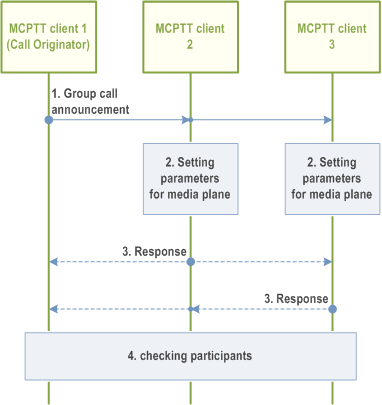
Step 1.
MCPTT client 1 as the group call originator sends group call announcement message to the group. This message contains the following parameters such as MCPTT group ID, group call originator identity, media type, media codec, multicast port number for media, port number for floor control protocol, period of group call announcement, and any encryption key for the media encryption if needed, and optionally confirm mode indication.
Step 2.
MCPTT client 2, 3 join the group call. The MCPTT clients configure the parameters for media delivery by making use of the received parameters in group call announcement.
Step 3.
MCPTT client 2, 3 may send the response message to the group when the group call announcement from originator includes confirm mode indication. This message contains MCPTT ID.
Step 4.
MCPTT client 2, 3 recognize the group call originator through the group call announcement and MCPTT client 1 checks the participants of the group call through the received response message.
10.6.3.4 Passive join to group call p. 104
Figure 10.6.3.4-1 illustrates the control plane procedures for the passive MCPTT client to join the on-going MCPTT group call. The passive MCPTT client does not initiate to establish an MCPTT group call, but receives the group call announcement to be transferred periodically. When receiving the announcement message with parameters for media transfer, the passive MCPTT client configures the parameter to receive the voice and joins the announced MCPTT group call.
This procedure happens after the MCPTT group call is established. The group call announcement including the parameters for the media transfer has been performed periodically, in order for the MCPTT client later to join the MCPTT group call.
The MCPTT client 4 enters the coverage of the MCPTT group call lately.
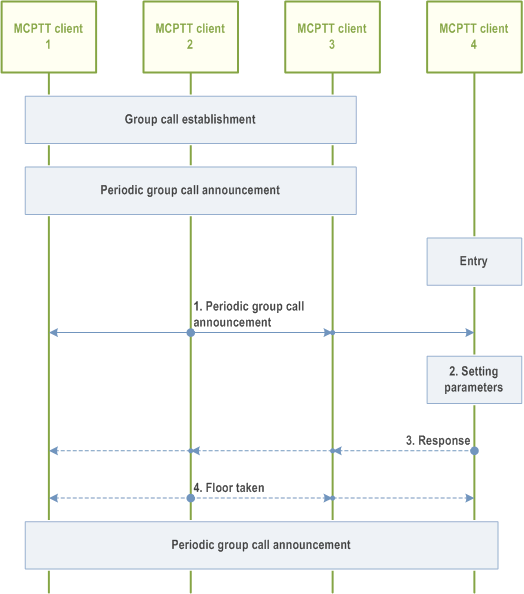
Step 1.
MCPTT client 2 sends the group call announcement message. This message contains parameters such as MCPTT group ID, group call originator identity, media type, media codec, multicast port number for media, port number for floor control protocol, any encryption key for the media encryption if needed, and optionally confirm mode indication.
Step 2.
MCPTT client 4 configures the parameters for media transfer by making use of the received parameters in group call announcement.
Step 3.
MCPTT client 4 may send the response message to the group when the periodic group call announcement includes confirm mode indication. This message contains the MCPTT ID.
Step 4.
MCPTT client 1, 2, 3 check through the received response message that the MCPTT client 4 joins the group call. The MCPTT client 2, as the floor control arbitrator, may send a floor taken message.
10.6.3.5 Join to ongoing group call when new entry member initiates the call with on-going group call id p. 105
Figure 10.6.3.5-1 illustrates the control plane procedures for an MCPTT client to join an on-going MCPTT group call. When entering the coverage of on-going group call, new MCPTT client may send group call setup announcement message with on-going group call id. Upon receiving the group call setup announcement, the MCPTT client as a participant of on-going MCPTT group call sends parameters for media transfer to the newly entered MCPTT client (entrant) to join the on-going MCPTT group call. When receiving the parameters for media transfer of on-going MCPTT group call, the MCPTT client configures the parameters to receive the voice and becomes the participant of the on-going MCPTT group call.
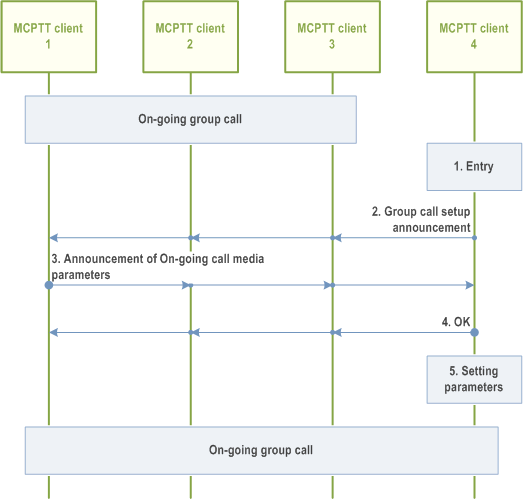
Step 1.
MCPTT client 4 joins and becomes participants of the on-going MCPTT group call.
MCPTT client 4 enters the coverage of the on-going MCPTT group call.
Step 2.
The new entry of MCPTT client 4 sends group call setup announcement with MCPTT group call id.
Step 3.
MCPTT client 1 as a participant of on-going MCPTT group call acknowledges that on-going MCPTT group call exists with MCPTT group call id sent by MCPTT client 4 and sends parameters for media transfer to MCPTT client 4.
Step 4.
MCPTT client 4 may send a response message.
Step 5.
MCPTT client 4 sets the parameters for media delivery in the on-going MCPTT group call.
10.6.3.6 Immediate group call announcement to join an ongoing group call p. 106
Figure 10.6.3.6-1 illustrates the control plane procedures for an MCPTT client to immediately join an on-going MCPTT group call. Upon the detection of a new entrant, the MCPTT client that is the current talker (floor arbitrator) immediately sends the group call announcement. When receiving the group call announcement message with parameters for media transfer, that MCPTT client configures the parameters to receive the voice and joins the on-going MCPTT group call.
Pre-conditions:
- There is on-going group call. MCPTT client 1 is the current talker and therefore the floor arbitrator.
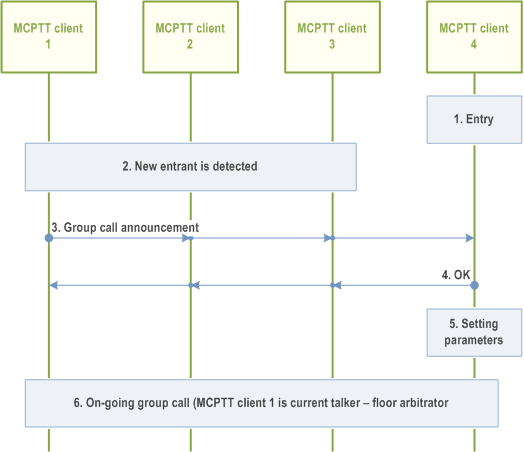
Step 1.
MCPTT client 4 enters the coverage of the on-going MCPTT group call.
Step 2.
The entry of MCPTT client 4 is detected by the current participants.
Step 3.
Since MCPTT client 1 is the current talker (floor arbitrator), MCPTT client 1 immediately sends the group call announcement with the call parameters to the group.
Step 4.
MCPTT client 4 may send a response message.
Step 5.
MCPTT client 4 sets the parameters for the group call.
Step 6.
All participants are now considered part of the on-going group call.
10.6.3.7 Group call release due to inactivity p. 107
If the on-going MCPTT group call is inactive for a specific duration, the participating MCPTT clients release the MCPTT group call by themselves.
10.6.3.8 Broadcast group call p. 108
Group call on group-broadcast group and user-broadcast group are handled without distinction in off-network.
Figure 10.6.3.8.1-1 illustrates the control plane procedures for broadcast group call in off-network.
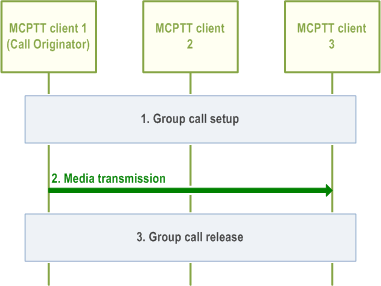
Step 1.
An authorized MCPTT client 1 initiates broadcast group call setup as described in subclause 10.6.3.3. The group call announcement message includes the indication of broadcast group call.
Step 2.
The MCPTT client 1 initiating broadcast group call starts to transmit media.
Step 3.
The broadcast group call is released as described in subclause 10.6.3.7.
10.6.3.9 Emergency and imminent peril procedures p. 108
10.6.3.9.1 Emergency group call p. 108
The off-network emergency group call is a special case of off-network (non-emergency) group call as defined in subclause 10.6.3.2, subclause 10.6.3.3, subclause 10.6.3.4, subclause 10.6.3.5, subclause 10.6.3.6 and subclause 10.6.3.7. The following are modifications to the aforementioned subclauses to support MCPTT emergency group calls:
- As a pre-condition, the client initiating the emergency call has previously been provisioned with an MCPTT group designated as the MCPTT emergency group. The MCPTT client initiates MCPTT emergency group calls on this group. Alternatively, the MCPTT client could have been provisioned for emergency behaviour on the selected MCPTT group.
- The group call announcement contains an indication that the MCPTT group call is to be an MCPTT emergency call regardless of whether or not the MCPTT client is in call. Group call participants learn of the MCPTT group's in-progress emergency state from the indication.
- Every call initiated by the MCPTT client will be an emergency call while the MCPTT client is in MCPTT emergency state.
- The MCPTT client enters the MCPTT emergency state when initiating an MCPTT emergency call or MCPTT emergency alert. Only the MCPTT user of the MCPTT client can clear the client's local MCPTT emergency state.
- The MCPTT group in-progress emergency state is cancelled when the call ends.
- The MCPTT user who initiated an emergency call, or upgraded a group call to an emergency call, or an authorized user, may cancel the in-progress emergency state with an MCPTT emergency group state cancel message. The message is sent to the call participants.
- When the MCPTT group is no longer in the in-progress emergency state, every client returns its default value of ProSe Per Packet Priority.
- An MCPTT group call in-progress is upgraded to an emergency group call when the periodic group call announcement contains the emergency indicator.
- The value of ProSe Per Packet Priority is upgraded according to emergency state of MCPTT group call.
- An MCPTT group call becoming an emergency group call does not affect the state of other MCPTT call(s) in the client.
- The MCPTT group remains in the in-progress emergency state until the emergency group call ends or the in-progress emergency state is cancelled.
10.6.3.9.2 MCPTT imminent peril p. 109
The off-network imminent peril group call is a special case of off-network (non-imminent peril) group call as defined in subclause 10.6.3.2, subclause 10.6.3.3, subclause 10.6.3.4, subclause 10.6.3.5, subclause 10.6.3.6 and subclause 10.6.3.7. The following are modifications to the aforementioned subclauses to support MCPTT imminent peril calls:
- As a pre-condition, the user initiating the imminent peril call has previously an MCPTT group to be used as the MCPTT imminent peril group. The MCPTT client initiates MCPTT imminent peril group calls on this group.
- The group call announcement contains an indication that the MCPTT group call is to be an MCPTT imminent peril call. Group call participants learn of the MCPTT group in-progress imminent peril condition from the indication.
- The MCPTT group in-progress imminent peril state is considered cancelled when the call ends.
- The originating MCPTT user of the in-progress imminent peril or an authorized user may cancel the in-progress imminent peril state with an MCPTT imminent peril group cancel. The message is sent to the call participants.
- When the MCPTT in-progress imminent peril is no longer in the in-progress imminent peril state, every MCPTT client returns its bearer to the priority it had prior to the in-progress imminent peril state.
- An MCPTT upgrade to imminent peril call is used to upgrade an MCPTT group call already in progress. The message is sent to all call participants so that they are aware of the in-progress imminent peril.
- The bearer is upgraded by all participants for the MCPTT group call already in progress when the MCPTT group call is upgraded to in-progress imminent peril state.
- An MCPTT imminent peril call puts the MCPTT group into the in-progress imminent peril state.
10.6.3.9.3 MCPTT emergency alert (off-network) p. 109
The MCPTT service shall support the procedures and related information flows as specified in subclauses 10.10.2 of TS 23.280 with the following clarifications:
- The MC service client is the MCPTT client;
- The MC service server is the MCPTT server;
- The MC service group ID is the MCPTT Group ID; and
- The MC service user profile index is the MCPTT user profile index.